Invented by Gregory Frederick Molnar, Luke Johnson, David Escobar Sanabria, II Edward Mark Bello, Jerrold L. Vitek, Matthew D. Johnson, University of Minnesota
DBS is a surgical procedure that involves implanting electrodes into specific areas of the brain. These electrodes deliver electrical impulses to modulate abnormal brain activity, thereby alleviating symptoms associated with neurological disorders. Traditional DBS systems have been successful in managing symptoms for many patients, but they often target a single symptom or focus on a specific area of the brain.
However, recent advancements in DBS technology have led to the development of multi-modal, multi-symptom neuromodulation systems. These systems offer a more comprehensive approach by targeting multiple symptoms and utilizing various modes of stimulation. This allows for a more personalized treatment plan tailored to each patient’s specific needs.
The market for these advanced DBS systems is driven by several factors. Firstly, the increasing prevalence of neurological disorders, such as Parkinson’s disease, has created a growing demand for effective treatment options. According to the Parkinson’s Foundation, approximately 10 million people worldwide are living with this disease, and this number is expected to double by 2040. As a result, there is a pressing need for innovative therapies that can improve the quality of life for these patients.
Secondly, advancements in technology have made these multi-modal, multi-symptom neuromodulation systems more accessible and user-friendly. The integration of advanced imaging techniques, such as magnetic resonance imaging (MRI), allows for precise electrode placement and real-time monitoring of brain activity. Additionally, the development of rechargeable battery systems has eliminated the need for frequent surgical interventions, reducing the overall cost and inconvenience for patients.
Furthermore, the positive clinical outcomes observed with these advanced DBS systems have contributed to their market growth. Studies have shown that multi-modal, multi-symptom neuromodulation can lead to significant improvements in motor function, reduction in medication requirements, and enhanced quality of life for patients. These promising results have garnered attention from healthcare professionals and patients alike, driving the demand for these innovative therapies.
The market for deep brain stimulation systems and methods with multi-modal, multi-symptom neuromodulation is expected to witness substantial growth in the coming years. According to a report by Grand View Research, the global DBS market is projected to reach $2.1 billion by 2027, with a compound annual growth rate of 9.4%. This growth can be attributed to the increasing prevalence of neurological disorders, advancements in technology, and the positive clinical outcomes associated with these innovative therapies.
In conclusion, the market for deep brain stimulation systems and methods with multi-modal, multi-symptom neuromodulation is expanding rapidly. These advanced therapies offer new hope for patients suffering from neurological disorders by providing a more comprehensive and personalized treatment approach. With the increasing prevalence of these disorders and advancements in technology, the demand for these innovative therapies is expected to continue growing in the coming years.
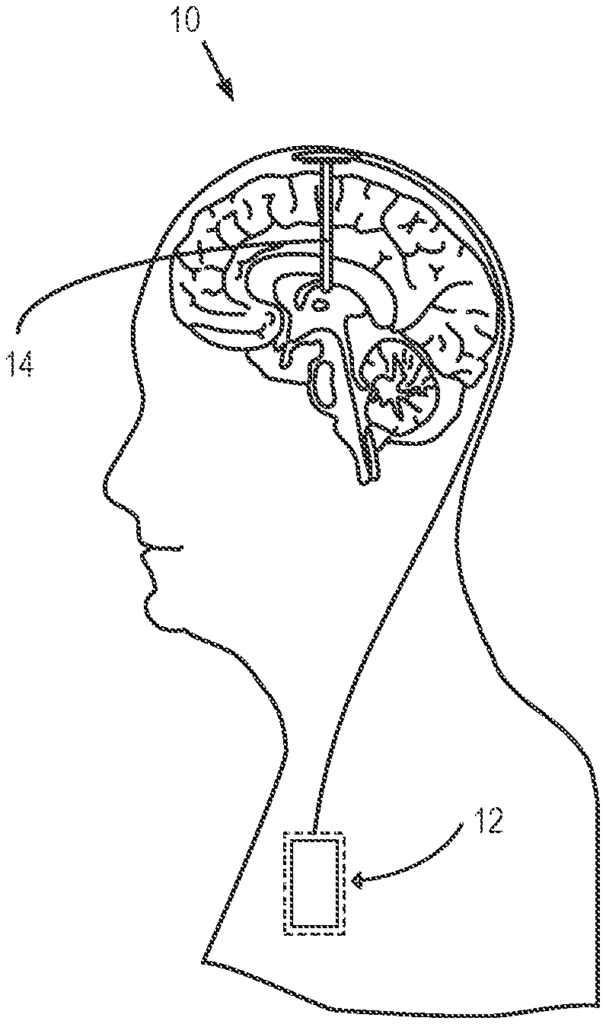
The University of Minnesota invention works as follows
The deep brain stimulation described here (?DBS?) This approach targets multiple relevant nodes in the brain circuitry while monitoring several symptoms to determine efficacy. This multi-symptom monitoring approach and stimulation therapy can be used in existing DBS devices. By optimizing DBS devices for multiple symptoms, such as sleep disturbances in addition to movement disorders, the therapeutic efficacy is increased.
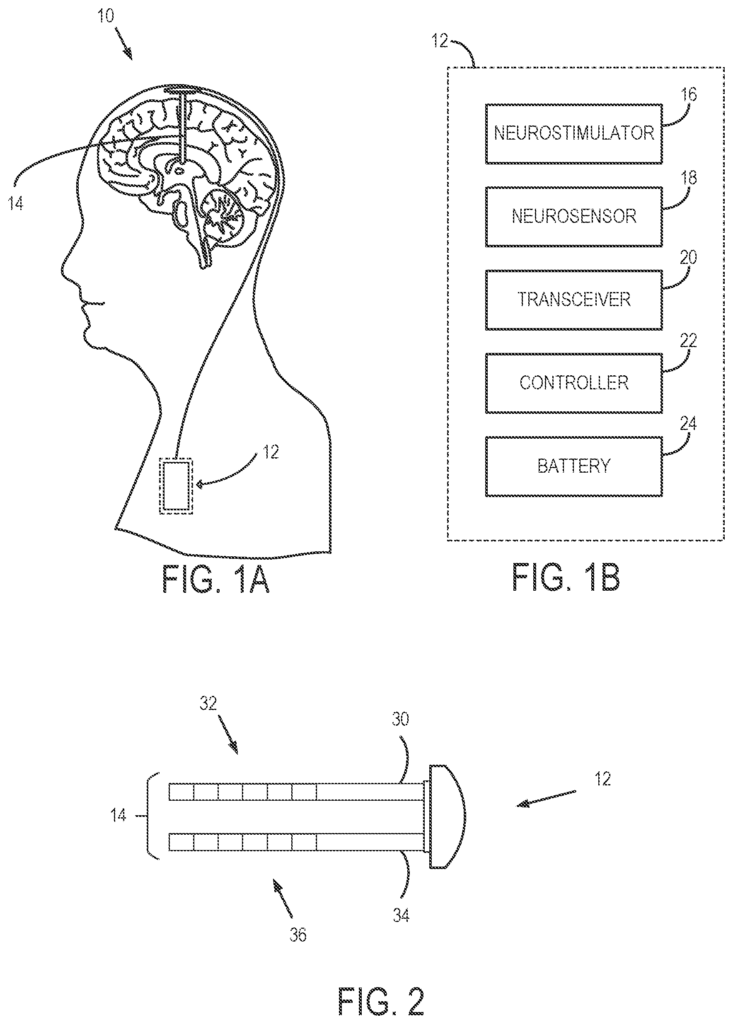
Background for Deep Brain Stimulation System and Method with Multi-Modal, Multi-Symptom Neuromodulation
Deep brain stimulation (DBS) has been proven to be an effective treatment option for individuals with Parkinson’s disease (PD). Deep brain stimulation (?DBS?) has been shown to be an effective option in treating motor symptoms of Parkinson’s patients. DBS is used to treat patients with medically intractable symptoms such as tremor, rigidity, and slowness of movement. Almost all patients with PD suffer from a sleep disorder that is as burdensome as their motor symptoms. In many cases, sleep disorders and other PD symptoms are not effectively treated. DBS is used to treat motor symptoms that appear during a patient’s awake state. However, no stimulation has ever been developed to treat sleep disorders, which are non-motor symptoms.
PD patients suffer the most from the lack complementary DBS tailored to their sleep-related comorbidities. Sleep disturbances, which were overlooked in the therapeutic DBS design until now, have a significant impact on this population’s quality of life. In 74%-98% of PD patients, sleep fragmentation, reduced sleep efficiency and total time, as well as rapid eye movement (RBD) are all reported. This distressing comorbidity has yet to be widely treated by DBS. It is likely that most PD patients will experience sleep disturbances of varying severity. Some people may experience symptoms that are even more severe and difficult to treat than motor symptoms. According to estimates, there are 1 million people living with PD in the United States. There are 1.2 million in Europe and 10 millions worldwide. These numbers will double by mid-21st Century. The National Institutes of Health – NINDS, due to its impact on the quality of life of PD patients and the scarcity of effective therapies, has designated the non-motor symptoms of PD such as sleep as a priority area.
The current standard of treatment for sleep disorders is based on pharmaceutical interventions, which vary in effectiveness and reliability among patients and are often associated with unwanted side effects. Antidepressants, non-benzodiazepine sleep aids, antihistamines and stimulants can be used to treat insomnia. Some patients may find these medications helpful in treating their sleep disorders, but they are also associated with serious side effects, including cognitive impairment, addiction, and abuse. These medications are also highly variable between subjects, leading to inconsistent results for patients with different sleep disorders. Clonazepam, a benzodiazepine, is a common medication used to treat REM sleep behaviour disorder (RBD). It can cause persistent effects during the day, including sedation, impaired cognition, and even falls. The efficacy of sleep medications is further complicated by the medication regimens administered to treat other symptoms. “For example, dopaminergic drugs used to treat the motor symptoms in patients with PD may cause sleep problems like insomnia or daytime sleep attacks.
We need more effective treatments that are less harmful for sleep disorders and other disorders. DBS is a solution that can be used for PD patients with motor symptoms who are already receiving this treatment. However, it does not have to be restricted to just this subset. DBS can be tailored to improve sleep in patients with severe sleep disorders that are resistant to treatment.
Sleep disorders can affect people of any age, from children to seniors. In exemplary embodiments of the disclosed invention, DBS sensing techniques and stimulation techniques are used to provide relief from sleep disorders and detection of sleep phases, while also continuing effective therapy for other symptoms treated with a DBS system. For example, motor symptoms in PD sufferers. DBS systems can be controlled to provide diagnostics and therapeutics, by tracking sleep architecture of the patient. This will improve sleep quality. DBS could be used to modify sleep in order to treat sleep disorders. This would not only benefit PD patients but also the general public, including those with treatment-resistant, intractable sleep disorders. A reduction in medication and side effects could improve a patient’s productivity and quality of life, as well as reduce healthcare costs.
In certain exemplary embodiments the invention can be implemented by existing DBS systems, which are enhanced/enhanced control mechanisms to target sleep disorders. (For example, via firmware updates). By implementing augmented control mechanisms into existing DBS systems, patients who have already been implanted can easily access expanded therapies without having to undergo additional surgery. Sleep disturbances among PD patients with DBS implants may be diagnosed and treated more effectively by detecting and modulating the sleep waves using the same deep-brain leads currently implanted for motor symptoms. This multi-objective therapy (e.g. treating motor and sleeping symptoms with the same device) is a paradigm change that patients, clinicians and the healthcare system will prefer because only one intervention is required to address multiple symptoms.
This disclosure presents a novel deep-brain-stimulating (DBS), multi-modal and targeted strategy for treating multiple symptoms at once. It is applicable to a variety of neurological conditions as well as co-morbidities. Neuromodulation therapy is often used to treat conditions with multiple symptoms, such as movement disorders, pain, and psychiatric problems. If a brain target is used in conjunction with a therapy to treat symptom, other symptoms or discomfort may occur. DBS may also be able to alleviate comorbidities associated with many neurological disorders.
For instance, PD can have both motor and non-motor symptoms like rigidity. The motor symptoms are currently treated with DBS to the subthalamic (STN), the globus pallidus, and the thalamus. Electrophysiological recordings can detect the stages and quality sleep in the same brain areas that receive DBS for motor symptoms. The same waveforms, patterns and frequencies can be used in stimulating these brain areas to enhance sleep.
Therefore, certain embodiments enhance DBS therapy by incorporating novel algorithm to detect, monitor and improve sleep. As discussed further below, these algorithms will include circuit-specific therapy signals at the right times. To promote sleep, these algorithms will incorporate circuit specific therapy signals at the appropriate times (see, e.g. FIG. While stimulating deep brain structures (see, for example, FIG. 4). In other embodiments of this multi-symptom and multi-modal therapy, new electrodes/leads can be used to cover multiple brain targets, and multiple sensors or wearables are also available to inform the DBS system about the clinical condition of the patient. Waveforms that are multiple and simultaneously applied can target brain circuits that cause certain symptoms. Neuromodulation can be achieved using a variety of stimulation methods (e.g. electrical, magnetic, optical, sound/ultrasound, etc.) Or targeted drug delivery therapies. The sensors can, for example, trigger an electrical modulation or communicate with an implanted pump to trigger the drug flow, or trigger a device programmer alert that the patient should take his or her oral medications on a scheduled basis or on ‘as-needed’ basis. Oral medications can be taken on a scheduled or PRN basis (i.e., as needed). The deep brain leads can modulate by optogenetic stimulation, in combination with external ultrasound or magnetic stimulators to achieve a combined effect.
The invention provides a novel way to span multiple brain targets in order to treat multiple symptoms. This method can be used at different times, depending on clinical symptoms or clinically relevant states such as awake versus sleep states. The use of novel DBS waves and stimulation parameters can be used to induce a sleep-like state in patients with sleep disturbances, both as a result of comorbidities, or in those with idiopathic disorders.
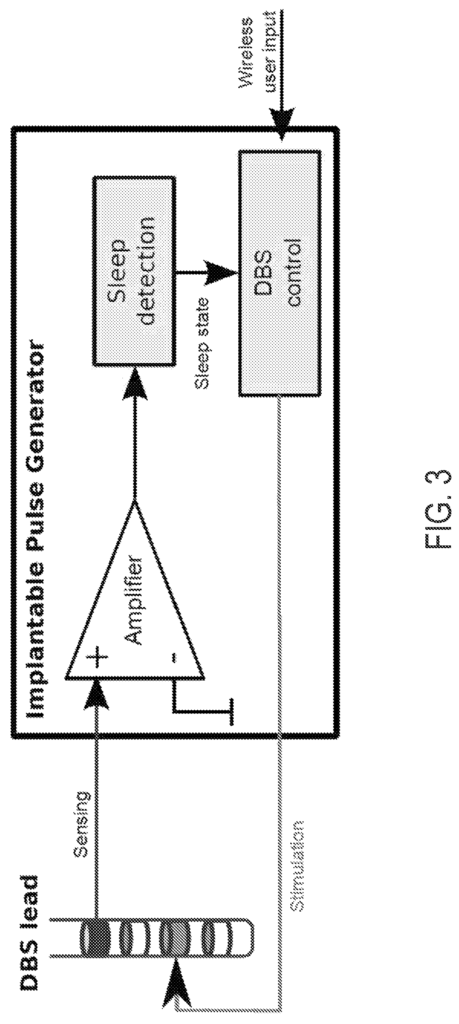
Multi-modal stimulation combined with multi-symptom-feedback can be an effective way to treat the primary symptoms associated with a DBS-ameliorable condition, as well as any DBS ameliorable comorbidities. DBS-induced symptoms are also monitored in real-time to control and counteract them. The same target can be stimulated with different parameters to improve sleep quality. Electrophysiological biomarkers can be monitored and adjusted to suit the state of sleep.
DBS is used to treat motor symptoms, but not for treating multiple brain targets that are associated with multiple symptoms. The use of pharmacological intervention may be reduced in the case of PD sleep disorders by using the DBS hardware already installed and delivering stimulation to improve sleep when necessary.
According to one aspect of this disclosure, a deep brain stimulation method for treating sleep disorders is disclosed. The method includes the following steps: receiving and processing the readings of a neurosensor that is implanted into the brain of a patient to evaluate the current state of the subject’s brain, the neurosensor connected to an implantable Pulse Generator (IPG); and, based on this current state, stimulating the subject’s brain via a Neurostimulator in order to induce a modified state of sleep, the Neurostimulator connected to the IPG.
According to another aspect of this disclosure, there is a method for treating at least two symptoms of a patient using deep brain stimulator (DBS). The method includes the following steps: receiving and evaluating readings from an implanted neurosensor in the brain of the subject, with the neurosensor connected to an implantable Pulse Generator (IPG); based on this current neural condition, stimulating the subject?s brain using a Neurostimulator, which is partially connected to the IPG.
According to yet another aspect of this disclosure, there is a system for treating sleep disorders using deep brain stimulation. The system comprises: a lead with a set electrodes for stimulating and reading one or more brain regions; an implantable pulse generation (IPG) that includes a neurostimulator, a neurosensor, and electrodes used to stimulate neurons while also obtaining readings. The IPG includes a controller that receives and processes electrical data from the brain of the subject via the Neurosensor in order to detect the subject’s current state. Based on this current state, the controller will stimulate the subject via the Neurostimulator.
The present disclosure provides a DBS system for treating sleep disorders using deep brain stimuli. The system comprises a controller that includes a processor with instructions that, once executed by the processor configure the DBS to: receive and analyze readings from a Neurosensor to evaluate the current state of a Subject, the Neurosensor being implanted into a Brain of a Subject and connected to an Implantable Pulse Generator (IPG); then, based on this current state, activate the brain via a Neurostimulator in order to induce a modified state of sleep.
According to a further aspect of the disclosure, there is a method for controlling a DBS implanted into a subject’s brain. The method comprises the following steps: receiving electrical information from a sub-cortical brain structure; analyzing the electrical data to determine a subject’s sleep stage; and adjusting the DBS control based on the determined sleep stage.
The present disclosure also provides a method for modulating sleep. The method involves the following steps: stimulating the sub-cortical brain structure of the implanted deep brain stimulator to change the sleep stage of a subject.
According to yet another aspect, a DBS system is provided. The DBS system comprises: a controller with a processor that executes instructions to configure the DBS so that it receives electrical data from a subcortical brain structure; analyzes the electrical data and determines whether the subject has entered a REM or NREM stage of sleep; and adjusts therapeutic stimulation of DBS based upon the determination that the subject has entered a REM or NREM stage of sleep.
According to yet another aspect of this disclosure, a system for deep brain stimulation is provided. The DBS system comprises: a controller, which includes a processor, and instructions, which, when executed by this processor, configure the DBS to: stimulate the subcortical structures of a brain to alter the sleep stage of a subject. Stimulating is done using a pattern of stimulation on the subcortical structures.
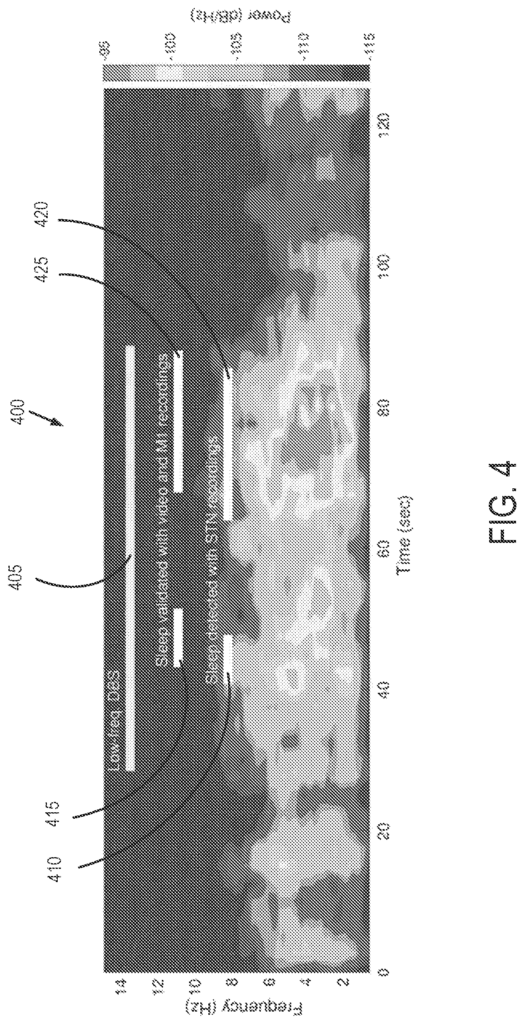
The following description will reveal the above and other aspects of the invention. The description makes reference to the drawings that are incorporated herein and which illustrate preferred embodiments. These embodiments may not represent the entire scope of invention. For that reason, the claims are used to interpret the invention.
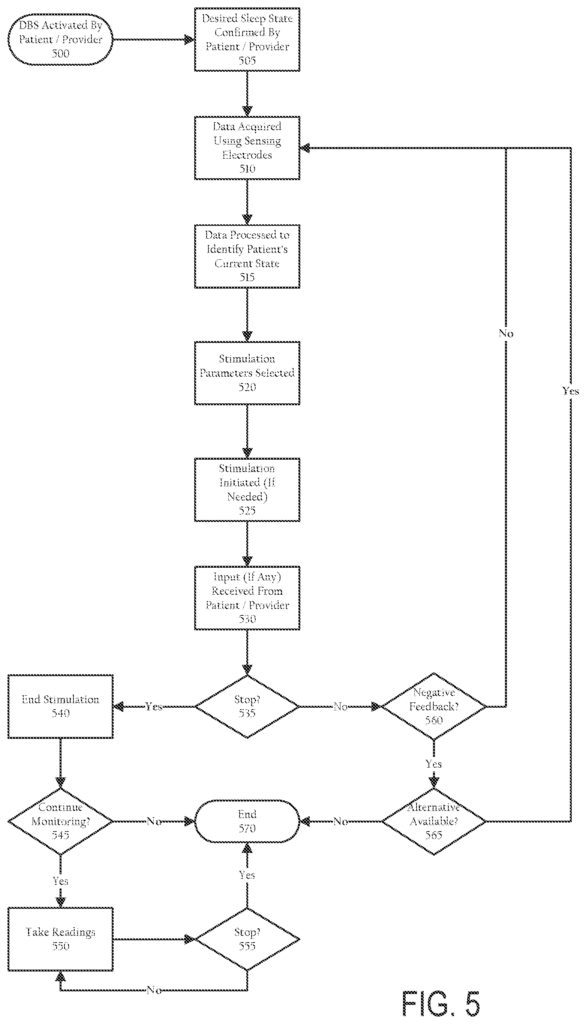
Click here to view the patent on Google Patents.
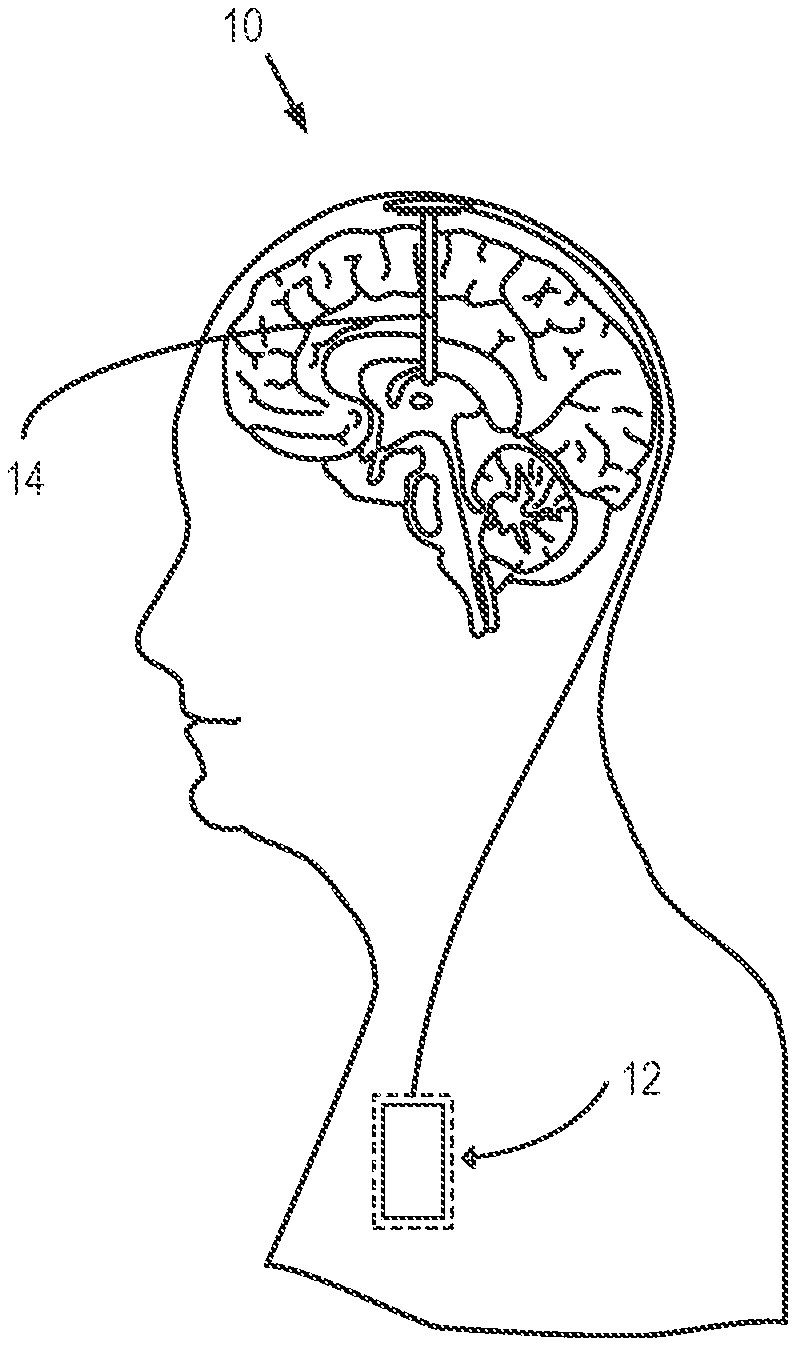
Leave a Reply